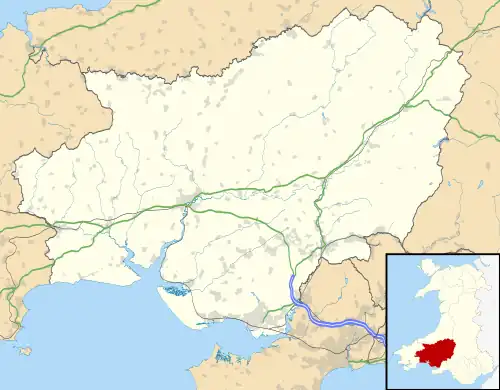| Laugharne Town Hall | |
|---|---|
| Native name Neuadd y Dref Talacharn | |
.jpg.webp) Town Hall | |
| Location | Market Street, Laugharne |
| Coordinates | 51°46′13″N 4°27′44″W / 51.7704°N 4.4622°W |
| Built | 1747 |
| Architectural style(s) | Italianate style |
Listed Building – Grade II* | |
| Official name | Laugharne Town Hall |
| Designated | 2 December 1951 |
| Reference no. | 9659 |
 Shown in Carmarthenshire | |
Laugharne Town Hall (Welsh: Neuadd y Dref Talacharn) is a municipal building in Market Street in Laugharne, Carmarthenshire, Wales. The structure, which is the meeting place of Laugharne Corporation, is a Grade II* listed building.[1]
History
.jpg.webp)
The first municipal building in the town was an ancient guildhall located on or near the same site which may have dated back to the formation of Laugharne Corporation by the Marcher Lord, Sir Guy de Brian (Gui de Brienne), in the late-13th century.[2][3] By the mid-18th century the tower had become ruined and civic leaders decided to erect a new structure.[4] The new building was designed in the Italianate style, built in rubble masonry with a whitewash finish and was completed in 1747.[1][5]
The design involved an asymmetrical main frontage with a hall section of two bays facing onto Market Street with rusticated quoins and an attached tower. The hall section featured two segmental headed openings with wrought iron grills and voussoirs on the ground floor and two windows on the first floor. The tower, which featured clock faces on the north and south sides, was surmounted by a pyramid-shaped roof. Internally, the principal rooms were the market hall on the ground floor and the courtroom on the first floor.[1]
A lean-to containing a lock-up for petty criminals was added to the east side in 1774, a bellcote with a bell designed and cast by Rudhall of Gloucester together with a weather vane in the form of a peacock were added to the roof in 1786, and the first floor was re-fenestrated with Gothic-style sash windows in 1814.[1]
Following the implementation of the Municipal Corporations Act 1883, which abolished the borough council,[6][7] fortnightly meetings of the court baron continued take place in the town hall under the auspices of a Grand Jury, which was presided over by the portreeve, acting as the chief magistrate, to ensure the corporation's extensive property portfolio continued to be properly managed.[8][9][10]
The clock was replaced in the late 19th century and a gabled porch was added in 1910.[1] In the early 1950s, the poet, Dylan Thomas, who lived in the town, wrote to his patron, Margaret Taylor, describing Laugharne as "timeless" and, with the town hall in mind, claiming that "it's clock tells the time backwards".[11][12]
See also
References
- 1 2 3 4 5 Cadw. "Laugharne Town Hall (9659)". National Historic Assets of Wales. Retrieved 15 May 2022.
- ↑ Lewis, Samuel (1849). "'Laleston - Lawrenny', in A Topographical Dictionary of Wales". London: British History Online. pp. 459–473. Retrieved 15 May 2022.
- ↑ "Walking: Laugharne". BBC. Retrieved 15 May 2022.
- ↑ An Inventory of the Ancient Monuments in Wales and Monmouthshire County of Carmarthen. Vol. 5. Royal Commission on the Ancient and Historical Monuments and Constructions in Wales and Monmouthshire. 1917. p. 64.
- ↑ The Rough Guide to Wales. Apa Publications. 2015. ISBN 9780241206256.
- ↑ Municipal Corporations Act 1883 (46 & 46 Vict. Ch. 18) (PDF). 1883. Retrieved 10 August 2023.
- ↑ "History". Laugharne Township Community Council. Retrieved 15 May 2022.
- ↑ "Open doors at Laugharne Town Hall". West Wales Family Life. Retrieved 15 May 2022.
- ↑ "Laugharne Corporation records". Archives Hub. Retrieved 15 May 2022.
- ↑ "The story of how a Welsh town continues its 700-year-old medieval tradition today". Wales Online. 6 October 2015. Retrieved 15 May 2022.
- ↑ Ackerman, John (1994). A Dylan Thomas Companion Life, Poetry and Prose. Palgrave Macmillan. p. 35. ISBN 978-1349133734.
- ↑ "Dylan Thomas's Laugharne, West Wales". The Richard Burton Online Museum. Retrieved 15 May 2022.
